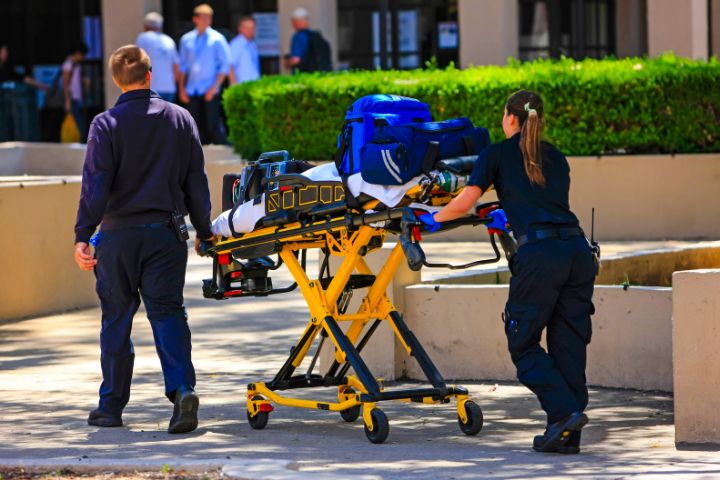You are interested in the EMS field but wonder where you should start! Is becoming an EMT or Paramedic the right choice? Exploring the two training programs and looking at the two careers can help you decide which path is right for you. Questions that often arise when exploring paramedics or EMT differences are the amount of schooling required and job responsibilities. We have outlined the differences and similarities between EMTs and Paramedics. Keep reading to find out more!
Learn more about our EMS programs
Key Differences between Emergency Medical Technicians and Paramedics Training
EMTs or emergency medical technicians are pivotal Emergency Medical Service team members. EMTs are usually the first responders on medical callouts. An EMT’s job includes
immediately assessing and stabilizing patients during a medical incident or situation. EMTs perform basic life support skills such as CPR, bandaging, controlling bleeding, and usage of defibrillators to restart a patient’s heart in an emergency. When EMT students enter an EMT training program, they can learn the skills needed for the job and receive education on determining injuries and illnesses. In order to enter in a training program future emergency medical technicians generally only need a high school diploma or GED to enroll in a program.
Like EMTs, Paramedics are qualified health professionals who are often first on the scene for an EMS callout. Of all the differences between EMTs and Paramedics, the greater responsibilities of a paramedic is most notable. Paramedics provide essential life support and advanced skills such as IV therapy and medication administration. Paramedics have more advanced medical qualifications, knowledge, and skills than EMTs and can perform necessary medical procedures which an EMT cannot, which means in order to become a paramedic further training is required. In addition, in order to become a Paramedic, one should have already completed their EMT training. In some cases, you may even need your EMT license in order to pursue paramedic training.
When deciding on a career as either an EMT or paramedic, the first step is to decide the time you want to commit to training. A paramedic program will be a longer time commitment than an emergency medical technician training program. Additionally each school may have different conditions for being accepted into a paramedic program so it is recommended to explore training program requirements.
Time Commitment to Training
Due to differences between EMTs and Paramedics, duties and training differ. Gaining an EMT certification and licensure offers a faster path into the profession. EMT students typically need about 170 hours of training. Again, this may vary from state to state. EMT programs can usually be completed in 4-5 months. In comparison, paramedics need about 1,200 to 1,800 hours of training (again, this might vary based on your state’s requirements).
A paramedic training program can be completed in 1 to 2 years. Paramedic training may be offered through a two-year degree program or institution. The classes include advanced training to prepare for more in-depth medical responsibilities.
- Physiology and anatomy
- Cardiology
- Advanced life support procedures
- Medications and application
Both training programs will involve a mix of in-class and in-the-field training. Both paramedics and EMTs will require state licensure. The biggest difference in pursuing a paramedic career is that the training is more advanced and will take longer.
What is the difference between the two careers?
The differences between EMTs’ and Paramedics’ jobs on the scene vary. Since they should be able to complete all the tasks of an EMT, a paramedic’s job has a broader range of responsibilities. Because of the advanced training required, Paramedics can conduct necessary medical procedures during an EMS incident, which can include:
- Intubating people
- Providing airway management
- Applying needle Cricothyrotomy to clear a patient’s airway if blocked or restricted
- Maintaining central lines on critical care ambulance
- Assisting in normal and abnormal birth processes
- Managing amputation accidents
EMTs may be called out to less urgent emergencies where they will perform duties while on the scene. For example, an EMTs role can vary significantly to include the following:
- Providing oxygen to patients
- Assisting in patient care, such as wound bandage
- Responding to 911 calls
- Transporting patients safely in an ambulance
- Documenting patient conditions and treatments
- Maintaining clean, safe well, stocked environment for patients
- Performing CPR and follow the lead of a paramedic
What EMS Career Fits You Best
Consider the workplace when deciding if you want to be an EMT or paramedic. Paramedics can function in other work environments because of their skill sets, such as working in Fire, Police, and ships, resorts, or flights.
EMTs often provide front-line medical cover at smaller venues and facilities; they can work as an emergency dispatcher, in rescue services, in private emergency vehicles, or ambulance companies. Due to their training and skill level, paramedics may have more options.
No matter what career choice, both require personality traits and soft skills to obtain the job positions because they work with members of the community regularly and are frequently exposed to stressful, emergency situations. Explore below personality traits and soft skills necessary to be successful as an EMT or paramedic.
Five essential skills needed for paramedics or EMTs:
- Teamwork
- Ability to navigate challenging situations
- Think creatively
- Mental toughness
- Situational Awareness
Qualities every EMT or Paramedic should have:
- Problem-Solving Skills
- Compassion
- Hunger for Learning
- Empathy
- Attention to Detail
- Flexibility
- Positive Attitude
To help you decide, consider the workplace environment that you see yourself working in. Also, take in account the amount of schooling you want to put in and how vital an advancement is to you. You may consider choosing to become an EMT and pursue becoming a paramedic later on as an option as well. Once these questions are answered, you can select an emergency medical service program that works for you.
Picking an Emergency Medical Services program that Works for You!
Now that you have a better understanding of the differences between EMTs and Paramedics, you must find a state-approved EMT or Paramedic training program that suits you. Here at Dorsey College, our comprehensive training programs can give you the knowledge and skills needed to take the NREMT exams and start your EMS career.
With three fantastic Michigan campus locations in Madison Heights (main campus),Woodhaven (branch campus of Madison Heights), and Grand Rapids (branch campus of Madison Heights) you can study on-site or learn through our Emergency Medical Technician or Paramedic classes. Our objective here at Dorsey College is to successfully prepare you for an exciting new career in Emergency Medical Services.
Contact Dorsey today to start your medical career journey as an EMT or Paramedic!
Dorsey College has determined that its Emergency Medical Technician training program curriculum is sufficient to fulfill educational requirements for licensure in the State of Michigan only. No educational determinations have been made for any other state, district, or US territory in regards to licensure requirements.
Dorsey College has determined that its Paramedic program curriculum is sufficient to fulfill educational requirements for licensure in the State of Michigan only. No educational determinations have been made for any other state, district or US territory in regards to licensure requirements.

